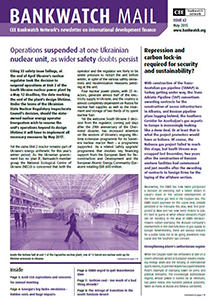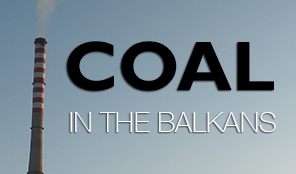Where will all that power go? New study assesses extravagant energy ambitions in the western Balkans

Bankwatch Mail | 14 May 2015
Western Balkan countries have ambitious plans to increase their electricity generation over the next years. But what will happen if they all become a regional energy hub? Will there be a demand for all the available electricity?
This article is from Issue 62 of our quarterly newsletter Bankwatch Mail
Browse all articles on the right
Hardly a week goes by without the media in the western Balkans reporting on some progress with a coal or hydro power plant project or reporting grand statements from politicians about their countries becoming regional energy hubs. In some cases this seems deeply improbable, with countries like Albania and Montenegro historically being electricity importers, but for others like Bosnia and Herzegovina (BiH) and Serbia – already net exporters most years – it seems reasonably plausible.
But what will happen if everyone becomes a regional energy hub? Where will all the electricity go? Is there likely to be a market for it at all?
Since Bankwatch had already been concerned that some of the planned Balkan electricity generation projects may be uneconomic (think of unit 7 at the Tuzla lignite-fired plan in BiH and the Boskov Most hydro power plant), we decided to investigate with the University of Groningen and the Advisory House consultancy what will happen if the promised electricity generation capacity really materialises. We know what to expect on the environmental side from coal and poorly-sited hydro power plants. But what about the economic side? Could coal and gas plants in the Balkans end up lying idle like their counterparts in Italy?
Export dependence a real possibility
Such significant electricity capacity expansions designed to meet export demand create the danger of becoming dependent upon the export market.
The first surprise was how difficult it was to find updated and realistic information on planned generation capacity investments. Some of the countries do not have any recent official energy strategy at all while others have, but they do not contain sufficient information and/or are internally contradictory.
Not unexpectedly, we found a large gap between government wish-lists of electricity projects and reality:
- Only one coal power plant (Stanari, BiH) is under construction in the region but up to 15 more are planned.
- Albania has 10 wind farms planned, but none are under construction.
- Small hydro power plants are being built – often in controversial locations – but still the number under construction is dwarfed by the number planned.
- Only five larger hydro power projects (10 MW+) are under construction or near to starting, compared to 37 others planned.
If no new capacity is built except that which is already under construction or near construction, and nothing is closed except that which is already announced, then the region will need to import electricity starting somewhere between 2018-2023, depending on demand levels.
At the other end of the spectrum, if the countries realise all their planned capacity extensions and demand growth is low, the region will have a 56 percent electricity surplus in 2024.
In particular BiH could turn into the largest exporter of electricity (up to 20,000 GWh), followed by Serbia (18,000 GWh). The other countries have a much lower potential contribution to the regional surplus, but measured in terms of their domestic demand, their export potential is substantial.
Such significant electricity capacity expansions designed to meet export demand create the danger of becoming dependent upon the export market. Our export analysis shows that there will not only be competition within the western Balkans but also from other nearby competitors such Bulgaria, Romania and the rest of the EU. Given an expected excess supply in Europe, increased competition may put pressure on export prices and increase the risk of incurring stranded assets – power plants that will become simply uneconomic to even operate.
For this reason, the study suggests closely examining investments that are directed to serve export markets and to also consider the trade-off of producing or buying electricity. Taking measures to reduce electricity losses is also crucial.
Read more
Stranded assets in the western Balkans – report on the long-term economic viability of new export capacities
Study | March 19, 2015
By the numbers: where will energy come from in the western Balkans?
Blog post | March 19, 2015
Electricity export ambitions may prove risky for Western Balkans, shows new study
Press release | March 19, 2015
Better planning is crucial – two key takeaways
First, planning across the region’s energy sector needs to be seriously improved. Strategies need to be better justified, clearer and more coherent. They should avoid including old projects which have already practically failed and take serious note of public comments.
Second, less is more. Why have huge lists of projects that are proving difficult to implement, when with more rational planning and analysis, a much smaller amount of investments would suffice? Energy efficiency should come first, and governments should not be afraid to cancel projects which have been hanging around for decades but never proved worth building.
Theme: Energy & climate | Social & economic impacts
Location: Albania | Bosnia and Herzegovina | Macedonia | Montenegro | Serbia | Kosovo
Project: Banovici lignite power plant, Bosnia and Herzegovina | Kolubara B lignite-fired power plant, Serbia | Kosova e Re lignite power plant, Kosovo | Kostolac lignite power plant, Serbia | Pljevlja II lignite power plant, Montenegro | Stanari lignite power plant, Bosnia and Herzegovina | Tuzla 7 lignite power plant, Bosnia and Herzegovina | Ugljevik III lignite power plant, Bosnia and Herzegovina
Tags: BW Mail 62 | Boskov Most | E.on | Enel | Tuzla | Western Balkans | coal | economics | electricity | energy | energy exports | hydropower | stranded assets
Never miss an update
We expose the risks of international public finance and bring critical updates from the ground. We believe that the billions of public money should work for people and the environment.
STAY INFORMED

